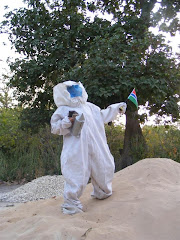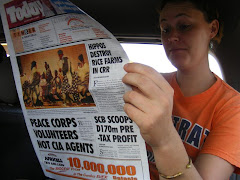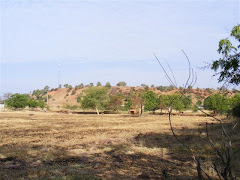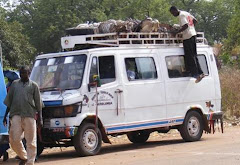In the past two months I've had a couple of successes and failures. I guess that both are bound to happen when you start trying to get something done.
Failures:
1) The Global Awareness Club that I tried to get started at the high school crashed and burned. The first week 30 kids showed up, the 2nd week 5, the 3rd week 0. I waited in the classroom for an hour until it became obvious that nobody was coming. It was pretty disheartening because I was really excited about getting the group going and I thought the first two meetings went fairly well. I realize now that there were a lot of things that I didn't understand going in to it and that I should have done differently. For one, I think the students had a hard time understanding my English since the English they are used to hearing is in an African accent with its own set of vocabulary. Second, the meetings were held on Saturday mornings at the headmaster's suggestion, but I realize now that no student is going to want to come to school on a Saturday morning. Third, my expectations of what the students were capable of and how much work they would be willing to do was unrealistic. I assumed that students in Grade 10 and 11 could at least read a newspaper article and write a simple paragraph for comprehension. I later found out that is not true.
I'm thinking of trying again and using a new approach. The headmaster at the school says that this time he'll find another teacher to help support me. The failure of the first time still stings, so its hard to get as enthusiastic as before. But last week I went to observe another high school club led by three Peace Corps Volunteers and it was so amazing to see the students debating about current events and thinking critically about issues. They were smart, engaged, articulate and confident. So I think I will give it another go, but this time I'm going to take it slow.
2) My garden was a little bit of a success and failure. After dealing with rats eating all my plants to stubs, caterpillar invasions, disease, and extreme heat I managed to keep my garden alive and for awhile it actually looked pretty healthy. But in the end, I'll I harvested after 5 months of work were 5 eggplants and 6 rats. My host family ate the rats (I would have tried it, but I wasn't around when they ate them) so they ended up getting some extra protein and that turned out the biggest output of my garden. It was a good learning experience, though, and my first attempt at gardening so I know next year will be a lot better. I never really expected to have a beautiful garden anyway; I just thought that it would be good for me to try gardening on my own before I try to tell other people what to do. And as it turns out, most of what I learned was from Gambians who knew how to do things much better than me in this harsh climate.
Successes:
1) I helped organize a training on a special kind of compost called bokashi. It's a labor intensive compost, but its cheap to make and really strong. Together with Malick, one of the field workers I work with at AVISU, we had a full day training where we trained 10 community members and 8 AVISU staff. I was nervous beforehand, but everything went really smoothly and everybody seemed to absorb the information and enjoy themselves. We even had a couple of breaks for singing and dancing. And at the end of the day we had a big pile of compost to leave at the community garden. Bokashi compost won't save the Gambia, but if nothing else one of my counterparts was empowered to lead a training, the community members felt involved and valued, and the AVISU staff were motivated and interacted as peers with one of the community groups.
2) We are finally entering a new era at AVISU with a new director and new management staff arriving soon. I am very excited about the new direction of the organization and that some of my suggestions for improving the organization are being implemented. I spend most of my time working at the office, so its really rewarding to see things moving in a positive direction.
3) I have helped create 5 tree nurseries, 4 in community gardens and 1 at the upper basic school totalling over 1000 trees. It was difficult to get the ball rolling, but now that things have started my work is done and I can just sit and watch the results. I'm hoping next year to try the same thing at a much bigger scale.
Follows my life as a Peace Corps volunteer in The Gambia, from Sep 2007 to Oct 2009.
Tuesday, June 3, 2008
Monday, June 2, 2008
The Coming Food Crisis
 In the media they often mention that the coming food crisis will affect the entire world, but that the worst impacts will be felt in Africa and Asia and especially in those developing countries that depend largely on imports for staple foods such as rice. The Gambia fits that profile perfectly: it is an African country, poor even by African standards; it is small and has little industry. The main livelihood is still subsistence agriculture but not enough food is produced to support the Gambian population (1.6 million). In fact, in 2007 the Gambia produced less than half of the food that was consumed. That means the country depends largely on food imports, especially of rice, the staple food and also the food commodity hardest hit by price rises. Add to this the fact that the agricultural production of the Gambia is actually declining due to desertification, deforestation, topsoil loss, and the detrimental effects of Gambia’s main crop, peanuts, to the soil, along with a rapidly growing population (due to immigration from neighboring war-torn countries, large families and declining death rates). Finally, last year’s harvest was very poor because of the lack of rain and so people have less money in hand and will be running out of the food they have stored even sooner than usual. All of this is set to collide with the coming of the annual hungry season, from June to September, when last year’s harvest begins to run out and the new harvest has yet to come in.
In the media they often mention that the coming food crisis will affect the entire world, but that the worst impacts will be felt in Africa and Asia and especially in those developing countries that depend largely on imports for staple foods such as rice. The Gambia fits that profile perfectly: it is an African country, poor even by African standards; it is small and has little industry. The main livelihood is still subsistence agriculture but not enough food is produced to support the Gambian population (1.6 million). In fact, in 2007 the Gambia produced less than half of the food that was consumed. That means the country depends largely on food imports, especially of rice, the staple food and also the food commodity hardest hit by price rises. Add to this the fact that the agricultural production of the Gambia is actually declining due to desertification, deforestation, topsoil loss, and the detrimental effects of Gambia’s main crop, peanuts, to the soil, along with a rapidly growing population (due to immigration from neighboring war-torn countries, large families and declining death rates). Finally, last year’s harvest was very poor because of the lack of rain and so people have less money in hand and will be running out of the food they have stored even sooner than usual. All of this is set to collide with the coming of the annual hungry season, from June to September, when last year’s harvest begins to run out and the new harvest has yet to come in.Roots of the Current Crisis
What is causing the global food crisis? It is a confluence of many factors that have led to this current crisis, all of which have been building for sometime, but which until now went largely ignored. Biofuels, the diverting of corn to ethanol, has largely been blamed for creating higher prices for staple foods, but in reality it is only a small piece of the puzzle. Many of the other factors are more difficult to face, because, for one, they have been building for many years right in front of our eyes and we did nothing about it, and two, there are no easy solutions on how to address the problems. One of the biggest contributing factors to the rise in global food prices is the rise of the middle class in China in India, which has led to a sharp increase in the demand for what was previously considered a luxury item: meat. China’s meat demand has risen to 50kg per capita from 20kg in 1980.[1] The production of meat requires large amounts of animal feed which are made from the staple grains on which the poorest people in the world rely. The production of 1 kg of quality animal protein requires around 6 kg of plant protein.
Another contributing, and uncomfortable, factor to the current food crisis is the fact that over the past decades, a global system has developed where the industrialized countries dump their excess food commodities on the developing world at very low prices, so low that they undercut the prices of locally grown food stuffs. Over the years, these developing countries have come to rely on the industrialized world for cheap food, and their tastes have changed so that even when the price of these previously cheap commodities like rice and corn goes up, people still prefer it to the cheaper local foods. Unfortunately for the developing world, the era of cheap food is over. The gradual reform and liberalization of agricultural subsidies in the US and Europe has reduced the overproduction of grains. This is largely seen as a good thing, as the former system distorted global prices and undercut developing countries food commodities which could not compete with the subsidized behemoths of the West and created the current system of dependency we see today. And the global demand for staple grains will continue to grow, so prices will never go back to their cheapest levels. But even if the cuts in subsidies in the West and higher prices for food commodities could be good in the long run, with more potential for small-scale farmers to profit, in the short-run it will be a very painful adjustment, especially for the world’s poorest, who spend 50-80% of their income on food already.
The global surge in oil prices has also led to an indirect increase in food prices. Higher oil prices means higher transportation costs, getting food from one place to another, and the higher costs are passed on to the consumer. The surge in oil prices is also not likely to abate. If anything, the predictions are that oil prices will continue to increase as demand continues to grow and oil becomes more difficult and expensive to extract.
Our increasing global population is also an uncomfortable truth that is contributing to the current crisis and has been ignored for too long. Every year we add 73 million new people to the Earth. Improvements in the intensity of production can only shoulder the increases in population for so long, and we are beginning to feel the effects now. The UN predicts that there will be over 9 billion people by mid-century, from 6 billion at the beginning of the century. We have to seriously begin considering how many people the world can really support and what we are willing to do about it.
And of course, there is global climate change. This last one is impossible to prove directly, but nonetheless, there is little way to deny anymore that climate change is real and that we are feeling the effects already. The Australian farm industry has been hard hit over the past few years because of drought, which is one contributing factor to the price hikes. And last year in West Africa, floods in some areas and sporadic rains in others led to poor harvests, exacerbating the food crisis in the region. Unfortunately, the negative effects of climate change will only continue to get worse, and it was predicted that it will most negatively impact the developing world.
What does all this mean? It means that The Gambia is set to be one of the hardest hit by the coming crisis. According to the Economist, the price of rice rose 141% between January and April. Last year the price of rice went up just 16%.[2] The price of a 50 kg bag of rice has already risen to D850 ($42.50) from D600 ($30.00) just months ago. Typically one bag of rice can feed a small family for one month. With a GDP of $356/year[3] this is already putting a serious strain on people. $356 per year averages out to $29.67 per month which means that the price of a bag of rice now exceeds average monthly income substantially. And of course GDP figures do not reflect the true reality of the poor because the poorest people in The Gambia already survive on much less; the numbers are skewed by the small but wealthy elite.
In a global sense, it means that the poorest people will struggle the most. It means that recent gains made in development could be easily reversed. According to Bob Zoellick, the president of the World Bank, food inflation could push at least 100 million people into poverty, wiping out all the gains the poorest billion have made in the last decade of economic growth.[4] It means that Gambians have to adapt to the new reality of higher food prices, because food prices will not be going down significantly in the future.
Adapting to the New Reality: Finding Opportunities in Times of Crisis
In a short time, inshallah, the rains will arrive in The Gambia and sowing will begin for this year’s harvest. In that short window of time, farmers have an opportunity to take advantage of higher food prices. If farmers can increase their yields for this season, either through improved farming techniques or increasing their cultivated land size, they stand to increase their profits for the crops they grow. If a farmer can grow enough to support his family for the year and still have some left over to sell at a high price, that farmer and his family could be better off than before. When food prices are high, those who can produce more than they need to eat can profit. And those who are willing to eat what is cheap (millet, pidgeonpeas, groundnuts) and sell what is expensive (rice, maize) can also thrive. Ironically, in the developing world, usually the foods that are the cheapest are also more nutritious than their staple alternatives, so promoting the consumption of cheaper foods also promotes better nutrition. When the pressure for food money really starts to build, the first things that will go will be vegetables and animal proteins which will mean a diet heavy in starch and carbohydrates. It fills the belly but does not provide all that the body needs. That means we need to promote alternative sources of nutrition that are cheap and easy to grow such as vegetables, beans, moringa and sweet potatoes. And it also means encouraging alternative income sources, such as beekeeping, poultry-production, fruit-tree orchards, timber lots, craftwork, etc.
Unfortunately, there are some major barriers to making this work. First of all, food production in The Gambia falls far short of reaching the demand in the country, so food imports will have to remain a part of the mix, at least for the near future. Second, the main crops grown in the Gambia are groundnuts and millet. Groundnuts, known as peanuts in the West, are an important part of the Gambian diet but are not a staple food and are mainly grown as a cash crop, though it fetches very low prices. Millet is a staple food and a traditional food but is viewed as inferior to rice, although it is more nutritious, and if it all possible, people prefer to buy rice. Buying rice is also a sign of status and so people are likely to sacrifice a lot in order to maintain that status symbol at the risk of their own health. Third, the level of mechanization in farming techniques is still at a very low level in The Gambia; almost everything is still done by hand and oxen. That means that the potential for rapidly increasing production levels is low because of a lack of infrastructure, equipment, knowledge and cultural acceptance. Even if the capital necessary to bring in equipment and infrastructure were available, it would take some years for the people to be able to adopt the dramatically different methods of farming and it would require overcoming cultural barriers to change. For many poor, rural and uneducated Gambians, farming is the only thing that they know, and for somebody from the outside, whether a foreign NGO worker or an educated, city-dwelling Gambian, to come in and try to change the way they’ve always done things and the way their ancestors always did things will be met with strong resistance. Fourth, there are other cultural barriers to changing methods of food production, such as gender roles. Traditionally, it is the men that cultivate the cash crops, such as peanuts and millet (although the women contribute labor), and take care of the cattle. It is the women that cultivate rice and grow vegetables in community gardens. Because the growing of rice is seen as “women’s work” and because women already carry such a heavy workload (cooking, cleaning, child rearing, selling in the market) it will be difficult to dramatically increase the amount of food they can grow. Men have slowly become more involved in rice cultivation, especially with the introduction of upland varieties such as Nerica that are not grown in marshland like the traditional rice varieties, but of course challenging the gender roles of any culture always takes time. And lastly, when the food and money runs out, the poorest people will be forced to sell everything they have, their animals, tools, seeds, land, just to get by – meaning that recovery, even to the substandard level at which they were living before, will be even more difficult.
What Gambians need in order to capitalize on the new reality and increase food security is technical training in how to increase the production levels of their crops, capital to invest in equipment, infrastructure provided by the government, such as roads, transport processing facilities, etc., and diversification of income-generating activities. But something needs to be done immediately to try to ease the crisis for this coming rainy season. The most essential things to do are to encourage farmers to increase their production for this year by educating them on the coming food price hikes and their potential to benefit if they increase their yields and to support them with technical training that will allow them to increase their harvest without having to dramatically expand the land they cultivate or their workloads. This means providing improved varieties of seeds, training on improved pest management, and training on cultivation and harvesting techniques. Different NGO’s have already started this work, but they will only be able to reach a small portion of farmers this year, which means that all we can do is hope that the harvest is especially good this year, and at least, that it is not bad. A poor harvest due to influences outside of human control, on top of an already precarious situation, could spell real disaster.
As an individual observing this building situation, it's difficult to know what to do. The factors that have led to this crisis are much bigger than any one person and trying to do anything to help feels like bailing out a sinking ship with a spoon. Nothing I do alone can change the global situation, that takes big shifts in world politics and lots of time. But somehow doing something seems better than doing nothing.
Subscribe to:
Posts (Atom)
.jpg)
.jpg)
.jpg)
.jpg)
.jpg)